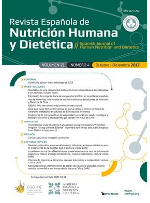Changes in the Modality of Nutritional Care of Hospitalized Patients During the COVID-19 Pandemic. A Descriptive Study in Health Establishment in Argentina.
DOI:
https://doi.org/10.14306/renhyd.27.2.1879Keywords:
COVID-19, Nutrition Assessment, Nutritionist, Nutritional Status, InpatientsAbstract
Introduction: One of the biggest challenges during the COVID-19 pandemic was carrying out an adequate nutritional assessment, while the risk of developing disease associated malnutrition became one more reason to perform nutritional screening as soon as possible. The aim of this study was to describe the changes that took place in the modality of nutritional assessment of hospitalized adult patients because of the COVID-19 pandemic during the year 2020 in health establishments with general hospitalization, public and private, of Argentina.
Methods: Descriptive, observational, cross-sectional study. Non-random sampling. Data from 60 institutions were obtained, through the application of a self-administered questionnaire aimed at Registered Dietitians and distributed through digital platforms. Data was processed with VCCStat – Beta3.0®. Descriptive statistics were calculated with CI 95%.
Results: 40% (95%CI 26.1-55.6) of the institutions that usually carried out nutritional screening suspended it in the case of patients with suspected or confirmed COVID-19, and 16% (95%CI 5.9-41.2) suspended its performance for all hospitalized patients. Nutritional assessment through interconsultation was observed in 18 institutions out of the 50 that used to perform it universally. Remote consultation was implemented in 53% of the establishments (95%CI 40,1-66,1), while in 22% (95%CI 12,5-34,5) the information was collected by another member of the Health Team. By the end of 2021, only 57% of the establishments (95%CI 43,4-69,2) had resumed the way of work prior to the year 2020. Changes impact was perceived as negative by 35% of the respondents (95%CI 23,4-48,5).
Conclusions: Main changes during 2020 included suspension of nutritional screening, nutritional assessment by interconsultation and implementation of remote care.
References
Álvarez J, Lallena S, Bernal M. Nutrición y pandemia de la COVID-19. Medicine. 2020;13(23): 1311-1321, DOI:10.1016/j.med.2020.12.013
Krznarić Ž, Bender DV, Laviano A, Cuerda C, Landi F, Monteiro R, et al. A simple remote nutritional screening tool and practical guidance for nutritional care in primary practice during the COVID-19 pandemic. Clin Nutr. 2020; 39(7) 1983-1987, DOI:10.1016/j.clnu.2020.05.006
Asús N, Kliger R, Stambullián M, Lorenzo J. Recomendaciones nutricionales para la atención de personas con infección por COVID-19. DIAETA. 2020; 38(171) 20-34. Disponible en: http://www.scielo.org.ar/scielo.php?script=sci_arttext&pid=S1852-73372020000200020&lng=es.
Ali AM, Kunugi H. Approaches to Nutritional Screening in Patients with Coronavirus Disease 2019 (COVID-19). Int. J. Environ Res. Public Health. 2021; 18(5) 2772, DOI: 10.3390/ijerph18052772
Handu D, Moloney L, Rozga M, Cheng FW. Malnutrition Care During the COVID-19 Pandemic: Considerations for Registered Dietitian Nutritionists. J Acad Nutr Diet. 2021;121(5):979-987. doi:10.1016/j.jand.2020.05.012
Braunschweig C, Gómez S, Sheean PM. Impact of declines in nutritional status on outcomes in adult Patients hospitalized for more than 7 days. J Am Diet Assoc. 2000;100(11):1316-22; DOI: 10.1016/S0002-8223(00)00373-4.
Planas M, Audivert S, Pérez-Portabella C, Burgos R, Puiggròs C, Casanelles JM y col. Nutricional status among adult patients admitted to an university-affiliated hospital in Spain at the time of genoma. Clin Nutr. 2004;23(5):1016-24, DOI: 10.1016/j.clnu.2004.01.003.
Crivelli A, Perman M, Wyszynski F y col. Estudio AANEP 99: prevalencia de desnutrición en hospitales de la Argentina. Rev. med. Plata. 2001;35(3), 10-24.
Asociación Argentina de Nutrición Enteral y Parenteral. [Internet] Estudio AANEP 2014 [citado Enero 2023]. Disponible en: https://www.aanep.org.ar/es/contenidos/estudioaanep14
Rouget A, Vardon-Bounes F, Lorber P, et al. Prevalence of malnutrition in coronavirus disease 19: the NUTRICOV study. Br J Nutr. 2021;126(9):1296-1303. doi:10.1017/S0007114520005127
Larrazabal RB Jr, Perez BMB, Masamayor EMI, Chiu HHC, Palileo-Villanueva LAM. The prevalence of malnutrition and analysis of related factors among adult patients with the Coronavirus Disease 2019 (COVID 19) in a tertiary government hospital: The MalnutriCoV study. Clin Nutr ESPEN. 2021;42:98-104. doi:10.1016/j.clnesp.2021.02.009
Bedock D, Bel Lassen P, Mathian A, et al. Prevalence and severity of malnutrition in hospitalized COVID-19 patients. Clin Nutr ESPEN. 2020;40:214-219. doi:10.1016/j.clnesp.2020.09.018
Practicing Telehealth. Available online: https://www.eatrightpro.org/practice/practice-resources/telehealth/practicing-telehealth (accessed on 2 February 2021).
Fuganti Campos L, Alves Barreto P, Duprat Ceniccola G, et al. BRASPEN’s Nutritional Statement for Coping with COVID-19 in Hospitalized Patients. BRASPEN J. 2020; 35(1) 3-5, DOI: 10.37111/braspenj.parecerbraspen2020
Martindale R, Patel J, Taylor B, et al. [Internet] Nutrition therapy in the patient with COVID-19 disease requiring ICU care. [citado Enero 2023] Disponible en: http://www.nutritioncare.org/COVID19Resources/.
Barazzoni R, Bischoff SC, Krznaric Z et al. ESPEN expert statements and practical guidance for nutritional management of individuals with sars-cov-2 infection. Clin Nutr. 2020;39(6):1631-1638, DOI: 10.1016/j.clnu.2020.03.022.
Mueller C, Compher C, Ellen DM; American Society for Parenteral and Enteral Nutrition (A.S.P.E.N.) Board of Directors. A.S.P.E.N. clinical guidelines: Nutrition screening, assessment, and intervention in adults. JPEN J Parenter Enteral Nutr. 2011;35(1):16-24. doi:10.1177/0148607110389335
Kondrup J, Allison SP, Elia M, Vellas B, Plauth M; Educational and Clinical Practice Committee, European Society of Parenteral and Enteral Nutrition (ESPEN). ESPEN guidelines for nutrition screening 2002. Clin Nutr. 2003;22(4):415-421. doi:10.1016/s0261-5614(03)00098-0
Feng X, Liu Z, He X, et al. Risk of Malnutrition in Hospitalized COVID-19 Patients: A Systematic Review and Meta-Analysis. Nutrients. 2022;14(24):5267. Published 2022 Dec 10. doi:10.3390/nu14245267
Rozga, M.; Handu, D.; Kelley, K.; Jimenez, E.Y.; Martin, H.; Schofield, M.; Steiber, A. Telehealth During the COVID-19 Pandemic: A Cross-Sectional Survey of Registered Dietitian Nutritionists. J. Acad. Nutr. Diet. 2021, 121, 2524–2535. DOI:https://doi.org/10.1016/j.jand.2021.01.009
Gnagnarella P, Ferro Y, Monge T, Troiano E, Montalcini T, Pujia A, Mazza E. Telenutrition: Changes in Professional Practice and in the Nutritional Assessments of Italian Dietitian Nutritionists in the COVID-19 Era. Nutrients. 2022; 14(7):1359. https://doi.org/10.3390/nu14071359
Brunton C, Arensberg MB, Drawert S, Badaracco C, Everett W, McCauley SM. Perspectives of Registered Dietitian Nutritionists on Adoption of Telehealth for Nutrition Care during the COVID-19 Pandemic. Healthcare. 2021; 9(2):235. https://doi.org/10.3390/healthcare9020235
Additional Files
Published
How to Cite
Issue
Section
License
Copyright (c) 2020 María Daniela Rainieri, Silvina Salinas, Raquel Zunino

This work is licensed under a Creative Commons Attribution-NonCommercial-ShareAlike 4.0 International License.











